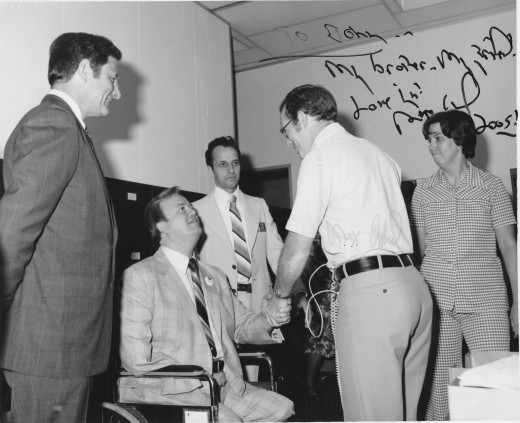Water Cooled (A veteran's wife takes charge, my first VA hearing)
Tilford meets Max Cleland, head of the Veterans Administration under Carter, in the Indianapolis VA Regional Office, 1977. Senator Birch Bayh on left.

It reminded me of the opening scene in an imitation Hitchcock, grade B movie. James Livingston, an Indianapolis Regional Office employee whom I barely knew, walked directly toward my temporarily assigned desk in the walk-in area on the first floor of the federal building. He bypassed the Dragon Lady receptionist without speaking. James was a permanent member of the local regional office appeals board. He introduced himself while handing me the claim folder for Michael Boggs.
“John, Mr. Boggs has an appeal hearing at one o’clock up in room 342. He has no appointed representative organization. Will you represent him?”
I had sat in on a grand total of two local appeal hearings during my preceding three years as a veteran’s benefits counselor. “Sure. Can you tell me something about the case?”
“It’s in the folder.” James then paused and – honest, he really did – looked both ways. Only then did he bend over slightly and add in a lowered voice, “Look at the date on the separation physical.” He then quickly returned to his full height of over six feet and walked away, not looking back. Presumably returning to his third floor desk near the stark appeal room with its one table and six chairs, three on each side.
I was relieved from helping any more walk-in veterans while preparing for the hearing, one hour away. When opened like a book a veteran’s claim folder, the “C-file”, has temporary documents such as compensation award input sheets on the left hand side. Permanent documents such as original application forms, copies of military separation documents, medical examinations, and rating decisions are on the right. Both the left and the right sides of the reddish-brown heavy cardboard folder are pierced at the top edge with two small holes to match the metal “binders” which held the papers – all similarly pierced at the top edge – inside the folder. This folder was easy to read. It was less than two inches thick.
I could not help but notice the more recent items on the right side as I flipped through toward the beginning of the story at the bottom of the chronologically arranged documents. Sometime around ten years earlier the veteran had indicated disagreement with the Veterans Administration’s denial of his claim for service connected disability for his left knee. He’d tried to raise the issue again more recently, but without success. He’d let more than one year elapse after the date of the initial denial without complaint and thereby left behind his initial appeal right and drifted unwittingly into the land of “We’ll reopen your claim if you submit some germane evidence which was not available at the time of the original decision and if we feel reopening is justified”. I made a mental note. Somebody had come up with something or the case would not be being considered for reopening and I would not be preparing for a hearing.
On that new quest I reversed course and flipped back toward the front/more current. The letters from the veteran still bore his signature, but the grammar was much improved, the writing was more legible, the composition more logical. Another mental note, although this one was more to satisfy my curiosity than help prepare for the hearing. I found that the reason for the hearing was that Mr. Boggs requested one through which to explain his basis for reopening face-to-face. Someone on the appeals board, I suspected Jim Livingston, had been unusually sympathetic and granted the hearing.
I resumed delving into the more distant past and found the separation physical to which Mr. Livingston had referred. The content was not significantly different than millions of other separation physicals except for three things: The Army doctor had concluded that Corporal Boggs’ documented left knee condition was 1) congenital (he actually had written “loose knee”) and 2) probably aggravated by a high school baseball injury mentioned by Corporal Boggs in the RFAD (release from active duty interview. Number three? The doctor had signed and dated the physical at 5:30pm on 31 December 1955. New Years Eve.
Twelve fifteen. Mr. Michael Boggs walks in with his wife, Margaret. We all shake hands and sit down at my temporary desk. Within less than a minute it becomes clear how barely high school educated, farm laborer, good old boy Michael Boggs could suddenly write so persuasively and why he had become so much more aggressive in pursuing his long-denied claim. Margaret was driving the train. Her man had been done wrong. She was writing the letters for his signature. Margaret may not have been to college, but she was certainly a sharp lady.
I tried to clarify the high school baseball injury. Michael replied that, yes, he had hurt his knee playing baseball his senior year but it had healed without surgery and he had played ball the remainder of that season. Additionally, he had worked without restriction on a farm for several months before enlisting in the Army. He never wore a supportive brace or bandage. Michael had, obviously, passed the pre-enlistment physical administered in Indianapolis. The same place and the same physical I had gone through on my way to the Marine Corps fourteen years later. All major joints, especially knees, drew a lot of attention during entrance physicals. I thought I had enough information to at least cast some doubt on the Army doctor’s opinion regarding the “congenitally loose knee”.
I thought about Livingston’s whispered comment and the New Years Eve separation physical. I knew Livingston would be one of the three VA specialists on the regional office appeal panel. I also suspected that one other gentleman I sort of knew, a Mr. Frazier, would be the VA lead panel member. I liked Frazier. (A few years later I worked with his daughter, Stephanie, in the Human Resources Branch, Indianapolis District Office, Internal Revenue Service. I had bailed out of the VA for more money at IRS.) I guessed that two of the three panel members would be sympathetic to Mr. Boggs.
Margaret carefully offered, one at a time, documents she had brought in a cardboard box. Most were duplicates of records and letters already in Michael’s claim folder. Except one. “Do you think this would help?” she slowly presented an award certificate. Bronze Star. Combat valor “V” device. No, that was not in his folder nor was it entered in the ‘awards’ block on Mr. Boggs’ separation document. It must have been awarded as he was leaving active duty, perhaps even after he had been separated. I could imagine Mr. Boggs opening a thick official envelope at his rural Indiana home. I read the citation on the certificate -
Corporal Michael Boggs’s company was about to be overrun by Chinese infantry. The screaming Chinese had already crested the ridge which had been the company’s main defensive line and were running down upon the second line of defense – if you could call it a line at that point. Some American soldiers had already broken and run. Michael Boggs saw what was happening and what was about to happen – a disorderly falling back turning into a rout. His assigned weapon was an M-1 rifle, eight rounds per clip. He was about to exhaust his clips. Michael saw that the .30 caliber water-cooled machine gunner and assistant gunner to his left had both been hit and the gun was out of action. Dropping his M-1, Michael picked up the 120 pound machine gun, still attached to its tripod. The connection between the water jacket around the barrel and the hose to the reservoir snapped. An almost full belt of ammunition dangled from the weapon. He charged up the hill, firing as he ran. As the first rank of Chinese fell, those behind heard the renewed rapid fire sound of the .30 cal, saw its effect, and stopped. More Chinese fell. The remaining turned and ran. Michael continued up the hill. Other men followed Michael, firing their weapons. Michael’s one-man counter attack, reinforced by others he inspired to action, worked. The Chinese attack had failed, the main defensive line was restored, the company saved.
“Yes, I think this might help.” Michael’s knee had worked pretty well as he charged up the hill. New evidence, never previously considered, germane to the issue. Justification for reopening. I was quiet for a few moments, thinking. Possible objection: adrenaline. Young mothers lifting cars off of their children. Small men knocking down doors to save people in burning buildings. Michael seeing his buddies being killed around him. Ignoring a congenitally bad knee?
Or did Michael hurt his knee during his heroism? The machine gun, with tripod and one belt of ammunition weighed about the same as he did. Maybe more. The first lunge forward would have had even more resistance because of snapping the connection to the water reservoir. Young, healthy knees have been damaged with less stress.
Or did Michael merely aggravate his really-was congenitally bad knee between the time of his heroism and his hasty New Years Eve RFAD physical examination? Some hardly noticed and long forgotten twist or slip?
Two out of three ain’t bad. “Let’s hold this until the actual hearing has started and then introduce it into consideration.”
We were upstairs in the hearing room. I don’t remember the elevator ride or walking down the hall. I think I was shaking. Mr. Frazier took charge. He introduced himself and the other two members of the panel. One was Jim Livingston. Then he went through a clear summary of the situation and the purpose of the hearing. The ‘new and germane’ requirements were part of the latter. The hearing went formal after the preliminaries. The recording system was turned on, voice levels checked. Frazier read the hearing identification information – date, purpose, Boggs’s name and claim number – into the record. A transcript would be typed by the never-seen typists in the typing pool behind a windowless door on the third floor and a copy mailed to Mr. Boggs for his corrective comments or approval. I would get a copy, just as if I was an American Legion or Veterans of Foreign Wars representative. Again I was both pleased and frightened that Michael had put me into this position by not selecting a service organization as his ‘power of attorney’.
Michael and Margaret came across as just as honest and straightforward as they really were. She, naturally, took the lead in describing how Michael’s knee disability caused problems on their small farm. He gave short answers to the questions from the members of the panel. The questions slowed and stopped and Mr. Frazier gave me the opportunity to provide a summary of Michael’s basis for reopening his claim. As surreptitiously guided by Livingston, I pointed out the presumed haste of the RFAD physical, conjecturing that the good doctor might have been in a hurry to leave work for the day, especially if he was anticipating a good party that evening. The panel members smiled. “I do agree with this military physician’s documentation of a left knee disability, just not his conclusion that it was congenital.”
Next: “I would like to introduce this document into the record. It’s a certificate for award of the Bronze Star with “V” device for Corporal Boggs.” I had run copies for each panel member. “If you read the citation you will notice that Corporal Boggs saved his company by picking up a water-cooled .30 machine gun and charging up a hill with it, firing as he ran. It would seem that his left knee worked pretty well on that occasion. I believe this document is new to the record, has not been previously considered, and – as it describes an impressive physical feat involving the strength and stability of his left knee – is pertinent. I also point out that his entrance physical is negative for any knee problems, left or right.”
“I think we can safely conclude that Mr. Boggs’s left knee disability as shown on his REFRAD physical arose during his honorable active military service.”
The hearing closed. We all said our good-byes. Mr. and Mrs. Boggs left the Minton-Capehart Federal Building at 575 North Pennsylvania Street, Indianapolis, Indiana and drove home to their farm. I never saw either of them again, except in memory.
A few weeks later I saw Jim in the elevator. Several other people were between us. I looked at him with a quizzical expression. He looked back at me and smiled, nodding his head.



